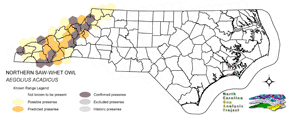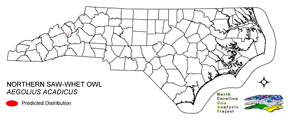
| Taxa: |
| Order: |
| Family: |
| Aves |
| Str.giformes |
| Strigidae |
| NatureServe Global Rank: |
| NatureServe State (NC) Rank: |
| G5 |
| S2B,S2N |
| Federal Status: |
| NC State Status: |
| --- |
| SC |


| Land Unit |
| US Fish & Wildlife Service |
| US Forest Service |
| US National Park Service |
| US Department of Defense |
| NC State Parks |
| NC University System |
| NC Wildlife Res. Com. |
| NC Forest Service |
| NC Div. of Coastal Mgmt. |
| Local Governments |
| Non-Governmental Org. |
| Other Public Lands |
| Private Lands |
| GAP Status 1-2 |
| All Protected Lands |
| Statewide |
| Hectares |
| 0.00 |
| 2,909.61 |
| 0.00 |
| 8,444.61 |
| 438.12 |
| 0.00 |
| 1.17 |
| 0.00 |
| 0.00 |
| 302.67 |
| 699.30 |
| 0.00 |
| 1,024.56 |
| 10,025.28 |
| 12,795.48 |
| 13,820.04 |
| Acres |
| 0.00 |
| 7,189.80 |
| 0.00 |
| 20,867.08 |
| 1,082.62 |
| 0.00 |
| 2.89 |
| 0.00 |
| 0.00 |
| 747.91 |
| 1,728.01 |
| 0.00 |
| 2,531.74 |
| 24,773.00 |
| 31,618.31 |
| 34,150.06 |
| % of Dist. on |
| Prot. Lands |
| 0.0 % |
| 22.7 % |
| 0.0 % |
| 66.0 % |
| 3.4 % |
| 0.0 % |
| < 0.1 % |
| 0.0 % |
| 0.0 % |
| 5.5 % |
| 5.5 % |
| 0.0 % |
| 0.0 % |
| 78.4 % |
| ----- |
| ----- |
| % of Dist. on |
| All Lands |
| 0.0 % |
| 21.1 % |
| 0.0 % |
| 61.1 % |
| 3.2 % |
| 0.0 % |
| < 0.1 % |
| 0.0 % |
| 0.0 % |
| 2.2 % |
| 5.1 % |
| 0.0 % |
| 7.4 % |
| 72.5 % |
| ----- |
| ----- |
|
Restricted to contiguous forests of spruce-fir and northern hardwood (Simpson 1992) in or near the Canadian zone of the Appalachian mountains (Crutchfield 1990). Nests in mature spruce-fir or northern hardwood forests containing large trees with cavities for nesting (Johnsgard 1988, Cannings 1993); utilizes forest openings and edges for foraging (Cannings 1993). Nests in cavities made by woodpeckers (usually Norther Flicker, Colaptes auratus, and Pileated Woodpecker, Dryocopus pileatus) that average about 7.5 cm in diameter, These cavities may be in living or dead conifer or hardwood trees (Johnsgard 1988). Will also use nest boxes (Cannings 1993). NATURE SERVE GLOBAL HABITAT COMMENTS: Dense coniferous or mixed forest, cedar groves, alder thickets, swamps, and tamarack bogs; also, when not breeding, in dense second growth, brushy areas, arid scrub, and open buildings. Often roosts in dense evergreens in winter, at various heights and usually close to the trunk (Condor 94:699-706). NATURE SERVE STATE HABITAT COMMENTS: Occurs in isolated pockets of boreal forest over 4500 ft. elevation. Although it primarily inhabits Spruce-fir forests, it also occurs in hardwood transition zones. Breeding sites appear to be confined to mature forest with trees generally 9-11 inches or larger in diameter with well-developed understories. REPRODUCTIVE HABITAT COMMENTS: Nests usually in old woodpecker hole, also in other tree cavity, or in nest box. Roosts during daylight in or near nest hole during breeding season (National Geographic Society 1983). Suitable holes have diameter of 7 cm or more. |
| Code | Name | Description | NC Natural Heritage Program Equivalent |
| 521 | Spruce/Fir Forest | High Elevation Frazer-Fir - Red Spruce, Red Spruce and Red-Spruce-Yellow Birch Forests. Tree densities included here include both woodland to forest density. Highly intermixed with Northern Hardwoods, Grassy Balds, and Shrub Balds. | Red Spruce--Fraser Fir Forest, Fraser Fir Forest |
|
Simpson MB Jr. 1992. Birds of the Blue Ridge Mountains. Chapel Hill and London: University of North Carolina Press.
Cannings, R.J. 1993. Northern Saw-whet Owl (Aegolius acadicus). In: Poole A, Gill F, eds. The birds of North America, no 42. Philadelphia: Academy of Natural Sciences. Washington: The American Ornithologistsí Union. 1-20. Crutchfield, P.J. 1990. Northern Saw-whet Owl. In: Lee DS, Parnell JF, eds. Endangered, threatened, and rare fauna of North Carolina. Part III. A re-evaluation of the birds. Occasional Papers of the North Carolina Biological Survey 1990-91. 34-36. National Geographic Society (NGS). 1983. Field guide to the birds of North America. National Geographic Society, Washington, D.C. Johnsgard, P. 1988. North American owls:biology and natural history. Smithsonian Inst. Press. 336 pp. |
For more information please contact them at:
NC-GAP Analysis Project
Dept. of Zoology, NCSU
Campus Box 7617
Raleigh, NC 27695-7617
(919) 513-2853
www.basic.ncsu.edu/ncgap